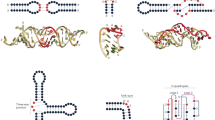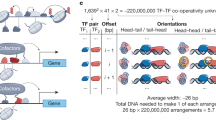Abstract
Genomic systematic evolution of ligands by exponential enrichment (Genomic SELEX) is an experimental procedure for the expression condition-independent identification of protein-binding RNAs. RNA libraries derived from genomic DNA are generated via random priming, PCR amplification and in vitro transcription. Libraries consist of genomic sequences of selected size, and fragments are flanked by constant sequences required for amplification and transcription. This RNA pool is then subjected to several rounds of selection and amplification to enrich for RNAs meeting the selection criteria. Various selection criteria are possible. Here we describe selection by affinity to a protein of interest. High-affinity ligands can then be cloned and sequenced to allow their identification. With this method, protein-binding RNAs can be discovered, nucleic acid–protein interactions can be identified, and whole protein–nucleic acid networks can be defined. This method is also suitable for discovering novel genes, including non-protein-coding RNAs, and it complements in silico approaches. It is better suited to detect protein-binding RNAs that are differentially expressed (and therefore absent from many tissues) and low-abundance RNAs than experimental procedures that start from the isolation of expressed RNAs. The protocol takes ∼3 months to complete.
This is a preview of subscription content, access via your institution
Access options
Subscribe to this journal
Receive 12 print issues and online access
$259.00 per year
only $21.58 per issue
Buy this article
- Purchase on Springer Link
- Instant access to full article PDF
Prices may be subject to local taxes which are calculated during checkout




Similar content being viewed by others
References
Tuerk, C. & Gold, L. Systematic evolution of ligands by exponential enrichment: RNA ligands to bacteriophage T4 DNA polymerase. Science 249, 505–510 (1990).
Gold, L., Polisky, B., Uhlenbeck, O.C. & Yarus, M. Diversity of oligonucleotide functions. Annu. Rev. Biochem. 64, 763–797 (1995).
Ellington, A.D. & Szostak, J.W. In vitro selection of RNA molecules that bind specific ligands. Nature 346, 818–822 (1990).
Singer, B., Shtatland, T., Brown, D. & Gold, L. Libraries for genomic SELEX. Nucleic Acids Res. 25, 781–786 (1997).
Shimida, T., Fujita, N., Maeda, M. & Ishihama, A. Systematic search for the Cra-binding promoters using genomic SELEX system. Genes Cells 10, 907–918 (2005).
Shtatland, T. et al. Interactions of Escherichia coli RNA with bacteriophage MS2 coat proteins: genomic SELEX. Nucleic Acids Res. 28, e93 (2000).
Kim, K., Shi, H., Lee, D.-K. & Lis, J.T. Specific SR protein-dependent splicing substrates identified through genomic SELEX. Nucleic Acids Res. 31, 1955–1961 (2003).
Mattick, J.S. Non-coding RNAs: the architects of eukaryotic complexity. EMBO Rep. 2, 986–991 (2001).
Tuschl, T. Functional genomics: RNA sets the standard. Nature 421, 220–221 (2003).
Mattick, J.S. The functional genomics of noncoding RNA. Science 309, 1527–1528 (2005).
Washietl, S., Hofacker, I.L. & Stadler, P.F. Fast and reliable prediction of noncoding RNAs. Proc. Natl. Acad. Sci. USA 102, 2454–2459 (2005).
Eddy, S.R. Computational genomics of noncoding RNA genes. Cell 109, 137–140 (2002).
Huettenhofer, A. & Vogel, J. Experimental approaches to identify non-coding RNAs. Nucleic Acids Res. 25, 781–786 (2006).
Wen, J.-D. & Gray, D.M. Selection of genomic sequences that bind tightly to Ff gene 5 protein: primer-free genomic SELEX. Nucleic Acids Res. 32, e182 (2004).
Zhang, A. et al. Global analysis of small RNA and mRNA targets of Hfq. Mol. Microbiol. 50, 1111–1124 (2003).
Sambrook, J. & Russel, D. Molecular Cloning: A Laboratory Manual. Cold Spring Harbor Laboratory Press, Cold Spring Harbor, New York, (2001).
Acknowledgements
Work in our laboratory is funded by the Austrian Science Fund (projects Z-72 and F1703), the Austrian BMBWK GenAu program and the European Community Research BACRNA FP6-018618.
Author information
Authors and Affiliations
Contributions
C.L. described the construction of the library, F.v.P. described the selection procedure, and R.S. authored the introduction and anticipated results sections.
Corresponding author
Ethics declarations
Competing interests
The authors declare no competing financial interests.
Rights and permissions
About this article
Cite this article
Lorenz, C., von Pelchrzim, F. & Schroeder, R. Genomic systematic evolution of ligands by exponential enrichment (Genomic SELEX) for the identification of protein-binding RNAs independent of their expression levels. Nat Protoc 1, 2204–2212 (2006). https://doi.org/10.1038/nprot.2006.372
Published:
Issue Date:
DOI: https://doi.org/10.1038/nprot.2006.372
This article is cited by
-
Advances in aptamer-based biosensors for monitoring foodborne pathogens
Journal of Food Science and Technology (2023)
-
Development of RNA G-quadruplex (rG4)-targeting l-RNA aptamers by rG4-SELEX
Nature Protocols (2022)
-
Recent advances on aptamer-based biosensors for detection of pathogenic bacteria
World Journal of Microbiology and Biotechnology (2021)
-
Acousto-microfluidics for screening of ssDNA aptamer
Scientific Reports (2016)
Comments
By submitting a comment you agree to abide by our Terms and Community Guidelines. If you find something abusive or that does not comply with our terms or guidelines please flag it as inappropriate.



